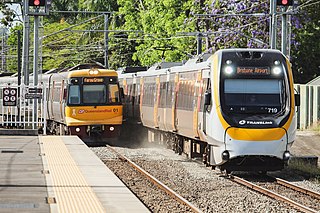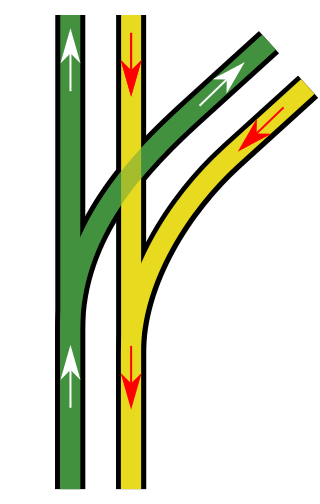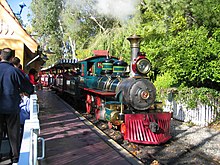
A broad-gauge railway is a railway with a track gauge broader than the 1,435 mm used by standard-gauge railways.

In rail transport, track gauge is the distance between the two rails of a railway track. All vehicles on a rail network must have wheelsets that are compatible with the track gauge. Since many different track gauges exist worldwide, gauge differences often present a barrier to wider operation on railway networks.

Rail transport in Australia is a component of the Australian transport system. It is to a large extent state-based, as each state largely has its own operations, with the interstate network being developed ever since Australia's federation in 1901. As of 2022, the Australian rail network consists of a total of 32,929 kilometres (20,461 mi) of track built to three major track gauges: 18,007 kilometres (11,189 mi) of standard gauge, 2,685 kilometres (1,668 mi) of broad gauge, and 11,914 kilometres (7,403 mi) of narrow gauge lines. Additionally, about 1,400 kilometres (870 mi) of 610 mm / 2 ft gauge lines support the sugar-cane industry. 3,488 kilometres (2,167 mi), around 11 percent of the Australian heavy railways network route-kilometres are electrified.

The Glyn Valley Tramway was a narrow-gauge railway that ran through the Ceiriog Valley in north-east Wales, connecting Chirk with Glyn Ceiriog in Denbighshire. The gauge of the line was 2 feet 4+1⁄4 inches (718 mm) while it was horse-drawn, which was unofficially increased to 2 ft 4+1⁄2 in when steam locomotives were introduced. The total length of the line was 8+1⁄4 miles (13.3 km), 6+1⁄2 miles (10.5 km) of which were worked by passenger trains, the remainder serving a large granite quarry and several minor slate quarries.

With railways, a break of gauge occurs where a line of one track gauge meets a line of a different gauge. Trains and rolling stock generally cannot run through without some form of conversion between gauges, leading to passengers having to change trains and freight requiring transloading or transshipping; this can add delays, costs, and inconvenience to travel on such a route.

Railways with a track gauge of 3 ft 6 in were first constructed as horse-drawn wagonways. The first intercity passenger railway to use 3 ft 6 in was constructed in Norway by Carl Abraham Pihl. From the mid-nineteenth century, the 3 ft 6 in gauge became widespread in the British Empire. In Africa it became known as the Cape gauge as it was adopted as the standard gauge for the Cape Government Railways in 1873, although it had already been established in Australia and New Zealand before that. It was adopted as a standard in New Zealand, South Africa, Indonesia, Japan, the Philippines, Taiwan, and Queensland in Australia.

A level junction is a railway junction that has a track configuration in which merging or crossing railroad lines provide track connections with each other that require trains to cross over in front of opposing traffic at grade.

There were more than a thousand British narrow-gauge railways ranging from large, historically significant common carriers to small, short-lived industrial railways. Many notable events in British railway history happened on narrow-gauge railways including the first use of steam locomotives, the first public railway and the first preserved railway.

Railways with a railway track gauge of 5 ft first appeared in the United Kingdom and the United States. This gauge became commonly known as "Russian gauge", because the government of the Russian Empire chose it in 1843. Former areas and states of the Empire have inherited this standard. However in 1970, Soviet Railways re-defined the gauge as 1,520 mm.

The rail network in Queensland, Australia, was the first in the world to adopt 1,067 mm narrow gauge for a main line, and, in 2013, was claimed to the second largest narrow gauge network in the world, consists of:

The Thamshavn Line was Norway's first electric railway, running from 1908 to 1974 in what is now Trøndelag county. Today it is operated as a heritage railway and is the world's oldest railway running on its original alternating current electrification scheme, using 6.6 kV 25 Hz AC. It was built to transport pyrites from the mines at Løkken Verk to the port at Thamshavn, as well as passengers. There were six stations: Thamshavn, Orkanger, Bårdshaug, Fannrem, Solbusøy and Svorkmo. The tracks were extended to Løkken Verk in 1910.

Rail transport in Australia involves a number of narrow-gauge railways. In some states they formed the core statewide network, but in the others they were either a few government branch lines, or privately owned and operated branch lines, often for mining, logging or industrial use.

Although most railways of central and eastern Canada were initially built to a 5 ft 6 in broad gauge, there were several, especially in Atlantic Canada and Ontario, which were built as individual narrow-gauge lines. These were generally less expensive to build, but were more vulnerable to frost heaving because vertical displacement of one rail caused greater angular deflection of the narrower two-rail running surface. Most of the longer examples were regauged starting in the 1880s as the railway network began to be bought up by larger companies.

The gauge for the most of the China national railway network is standard gauge. Currently, in the national railway network, only the 1,000 mmmetre gauge Kunming–Haiphong railway uses narrow gauge. In addition, there are some industrial lines still using narrow gauge, mostly 2 ft 6 in narrow gauge or 600 mm narrow gauge. As of 2003, 600+ km narrow-gauge railways, 50000+ km standard gauge railways, and 9.4 km broad gauge railways were in use in mainland China.

Bogie exchange is a system for operating railway wagons on two or more gauges to overcome difference in the track gauge. To perform a bogie exchange, a car is converted from one gauge to another by removing the bogies or trucks, and installing a new bogie with differently spaced wheels. It is generally limited to wagons and carriages, though the bogies on diesel locomotives can be exchanged if enough time is available.
Various track gauges are used in Hong Kong on different railways and railway lines.
Europe inherited a diversity of rail gauges. Extensive narrow-gauge railway networks exist in Spain, Central Europe and Southeastern Europe.
Asia has many narrow-gauge railways. The railways of Japan, Indonesia and the Philippines are predominantly 1,067 mm narrow gauge. Those in mainland Southeast Asia, which includes Vietnam, Cambodia, Laos, Thailand, Myanmar and Malaysia, are predominantly metre gauge. The proposed ASEAN Railway would be standard or dual gauge, using metre- and standard-gauge regional railway networks and linking Singapore through Malaysia, Thailand, Laos and Vietnam to China's standard-gauge rail network. In Western Asia, Jordan uses 1,050 mm narrow gauge.
Numerous narrow-gauge railway lines were built in Oceania, most in 3 ft 6 in, 2 ft 6 in and 2 ft track gauge.















